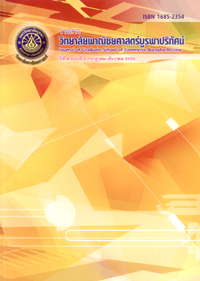ความแตกต่างของประสิทธิภาพการทำงานเป็นทีมและความสัมพันธ์การรับรู้วัฒนธรรมองค์การของพนักงาน บริษัท บริการวิศวกรรม จำกัด
Main Article Content
Abstract
การศึกษาความแตกต่างของประสิทธิภาพการทำงานเป็นทีมและความสัมพันธ์การรับรู้วัฒนธรรมองค์การ ของพนักงาน บริษัท บริการวิศวกรรม จำกัด มีวัตถุประสงค์ 1) เพื่อศึกษาระดับการรับรู้วัฒนธรรมองค์การ และ ระดับประสิทธิภาพการทำงานเป็นทีมของพนักงานบริษัท บริการวิศวกรรม จำกัด 2) เพื่อศึกษาเปรียบเทียบประสิทธิภาพ การทำงานเป็นทีมของพนักงานบริษัท บริการวิศวกรรม จำกัด ที่มีลักษณะประชากรศาสตร์แตกต่างกัน และ 3) เพื่อศึกษา ความสัมพันธ์ การรับรู้วัฒนธรรมองค์การกับประสิทธิภาพการทำงานเป็นทีมของพนักงานบริษัท บริการวิศวกรรม จำกัด กลุ่มตัวอย่างในการศึกษา ครั้งนี้ คือ พนักงานบริษัท บริการวิศวกรรม จำกัด จำนวน 240 คนโดยใช้วิธีการสุ่มแบบชั้นภูมิ (Stratified Random Sampling) แบบกำหนดสัดส่วน (Proportionate) ของพนักงานในแต่ละแผนก สถิติที่ใช้ในการวิเคราะห์ ข้อมูลได้แก่ ค่าร้อยละ ค่าเฉลี่ย ส่วนเบี่ยงเบนมาตรฐาน การทดสอบแบบ t-test การวิเคราะห์ความแปรปรวนทางเดียว (One way ANOVA) การเปรียบเทียบความแตกต่างเป็นรายตามวิธี LSD (Least-Significant Difference) และสัมประสิทธิ์ สหสัมพันธ์ของเพียรสัน (Pearson Product-moment Correlation Coefficient)
ผลการศึกษาพบว่า พนักงานบริษัท บริการวิศวกรรม จำกัด ส่วนใหญ่เป็นเพศชาย มีอายุระหว่าง 30-40 ปี มีการศึกษาระดับปริญญาตรี และมีระยะเวลาปฏิบัติงานไม่เกิน 5 ปี โดยมีการรับรู้วัฒนธรรมองค์การแบบความเหลื่อมล้ำ ของอำนาจในระดับมาก โดยมีค่าเฉลี่ยเท่ากับ 4.0302 และระดับประสิทธิภาพการทำงานเป็นทีมด้านวัตถุประสงค์และ เป้าหมายมี ความความชัดเจนและสอดคล้องอยู่ในระดับมาก โดยมีค่าเฉลี่ยเท่ากับ 3.6275 และพนักงานที่มีการศึกษาระดับต่ำกว่า ปริญญาตรีมีประสิทธิภาพการทำงานเป็นทีมโดยรวมสูงกว่าพนักงานทีมีการศึกษาระดับปริญญาตรีและสูงกว่าปริญญาตรี อย่างมีนัยสำคัญทางสถิติที่ระดับ 0.05 และการรับรู้วัฒนธรรมองค์การโดยรวมมีความสัมพันธ์กับประสิทธิภาพ การทำงานเป็นทีม ในระดับปานกลาง โดยมีค่าสัมประสิทธิ์สหสัมพันธ์ (r) เท่ากับ 0.651 และเป็นไปในทิศทางเดียวกัน อย่างมีนัยสำคัญทางสถิติที่ระดับ 0.01
DIFFERENCES OF TEAMWORK EFFECTIVENESS AND RELATIONSHIP OF ORGANIZATIONAL CULTURE PERCEPTION OF EMPLOYEE: A CASE STUDY OF BORIKARN WISAWAKARN COMPANY LIMITED
Anna Supasorn, Atchima Supachariyawat, Karin Boonlertvanich and Phuwarin Ninrungsri
Graduate School of Commerce, Burapha University, Chon Buri 20131, Thailand
This study is aimed 1) to examine level of organizational culture perception and level of teamwork effectiveness, 2) to compare teamwork effectiveness of employees with different demographic characteristics, and 3) to examine the relationship of organizational culture perception and teamwork effectiveness of employees at Borikarn Wisawakam Co., Ltd. The samples of this study which are consisted of 240 employees from different departments are derived from proportionately stratified random sampling. Statistics used for data analysis are percentage, means, standard deviation (SD), t-test, One Way ANOVA, LSD (Least-Significant Difference) comparison, and Pearson’s product moment correlation coefficient.
The findings show that the majority of the employees are male aged 30-40 years old who receive a Bachelor’s degree with collected employment duration of 5 years and/or less. The level of organizational culture perception in terms of power distance is high with means of 4.0302. The level of teamwork effectiveness in terms of consistent objective is high with means of 3.6275. Overall teamwork effectiveness of employees with lower than a Bachelor’s degree is higher than of employees with Bachelor’s degree and/or higher at statistical significance of 0.05. Overall organizational culture perception is correlated with teamwork effectiveness at moderate level with correlation (r) of 0.651 and be unidirectional at statistical significance of 0.01.
Article Details
The owner of the article does not copy or violate any of its copyright. If any copyright infringement occurs or prosecution, in any case, the Editorial Board is not involved in all the rights to the owner of the article to be performed.


